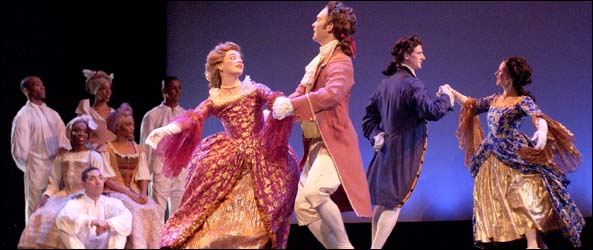| Want to send this page or a link to a friend? Click on mail at the top of this window. |
| Posted November 4, 2003 |
| Dance Review |
| Folk Meets Baroque At a Haitian Soirée |
 |
Richard Termine for The New York Times |
| Stylistic coherence: the New York Baroque Dance Company and Dallas Black Dance Theater in "Soirée Baroque en Haiti," at Florence Hall. |
| ___________________ |
| By ANNA KISSEGOFF |
| ___________________ |
It is 1790. Bewigged French colonial society and barefoot black slaves live different lives in Haiti but intermingle nonetheless. Such was the conceit, ingeniously and tastefully presented by Catherine Turocy's New York Baroque Dance Company and Ann Williams's Dallas Black Dance Theater as "Soirée Baroque en Haïti" at Florence Gould Hall on Saturday.
Before the current craze for Baroque opera, there was a quiet rebirth of interest in 17th- and 18th-century ballroom and theatrical dances. Ms. Turocy's reconstructions and original choreography in period style have varied in scale and spirit since 1976. But she has imaginatively familiarized audiences with the steps, conventions and images of Baroque dance.
In alternating French period dances and Haitian folk and religious customs, "Soirée Baroque" was a twist on New York Baroque's typical presentations. The Haitian dances were reconstructed by an American dancer and scholar, Marcea Daiter. Somehow the juxtaposition of two distinct styles and two distinct companies achieved stylistic coherence.
Lending his prestige to the evening, the veteran Haitian dancer Jean-Léon Destiné noted that the slaves would have mocked their master's stiff-backed dances. Those dances died out, he said, after the French were driven out of Haiti in 1804. On the eve of that revolution's bicentennial, "Soirée Baroque" entertained and illuminated.
James Richman and Concert Royal, his splendid Baroque musicians, were in the pit on Saturday to introduce a concerto by Joseph Boulogne, a composer from Haiti known as Chevalier de Saint-Georges. Mr. Richman noted that he took Paris by storm as "the black Mozart."
Other musicians were in the pit as well to provide the rhythm that Mr. Destiné said pulses through Haitian life. Damas Fan-Fan Louis, the fabulous New York-based master drummer, offered his subtleties in a solo and during the Haitian dances with two other drummers, Paul Daiter and Rogelio Teran.
The Baroque dances, representative of colonial society, included Elizabeth Aldrich's reconstruction of "La Valse," danced by Caroline Copeland and Timothy Wilson, and Ms. Turocy's "Menuet à Quatre," danced by Sarah Edgar, Ani Udovicki, Seth Williams and Mr. Wilson.
Haitian contredanse patterns reconstructed by Ms. Daiter were seen next with Nycole Ray, Melissa M. Young, Garfield Lemonius, Edmond Giles, Ingrid Abbott and Armando Silva from Dallas. All moved easily in different styles and rhythms, from the vigor of the spirit dances to the Baroque-flavored ensembles in which slaves and masters mixed. Mr. Giles offered a class act as the personification of the undulating deity Baron Samedi.
On the pretext that French singers in operas would have performed in Haiti, there was good work from David Rodriquez and Ms. Copeland as Gluck's Orpheus and Eurydice and in a tour de force solo by Ms. Turocy, assuming multiple personalities in "Les Caractères de la Danse."
The Concert Royal musicians contributing to this delightful evening were Mr. Richman, Cynthia Roberts, Judson Griffin, Tamara Meredith, James Gallagher, Christine Gummere and Melissa Slocum.
Copyright 2003 The New York Times Company. Reprinted from The New York Times, The Arts, of November 4, 2003.
| Wehaitians.com, the scholarly journal of democracy and human rights |
| More from wehaitians.com |